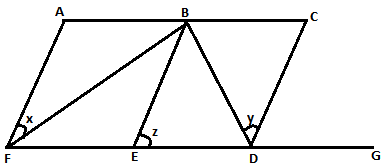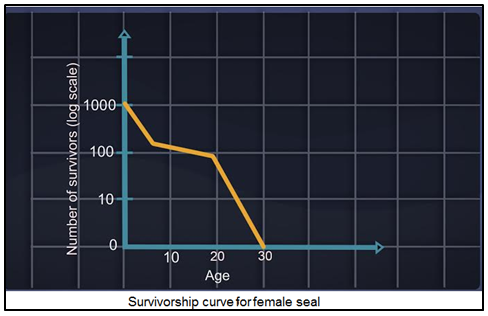12th Grade > Biology
ORGANISMS AND POPULATIONS MCQs
Total Questions : 57
| Page 6 of 6 pages
Answer: Option A. -> True
:
A
Survivorship curves are good indicators of lives of animals, their growth rate, growth strategies, how much parental care they provide and how they survive. For example,in grey seal, they generally follow K strategy of growth. However, the males have to fight each other to find mates. This weakens them and makes them more vulnerable and an easier prey. Thus, more number of males die early and the curve falls more rapidly forming a type II curve, whereas there is greater survivorship among female seals forming a type I curve. Survivorship curves for male and female seals are given below:


:
A
Survivorship curves are good indicators of lives of animals, their growth rate, growth strategies, how much parental care they provide and how they survive. For example,in grey seal, they generally follow K strategy of growth. However, the males have to fight each other to find mates. This weakens them and makes them more vulnerable and an easier prey. Thus, more number of males die early and the curve falls more rapidly forming a type II curve, whereas there is greater survivorship among female seals forming a type I curve. Survivorship curves for male and female seals are given below:


Answer: Option B. -> Mimicry
:
B
Unpalatable organisms develop honest warning signals to display their unpalatability andare avoided by predators, who quickly learn after a bad experience not to pursue the same prey again. This phenomenon of displaying antipredator signals is aposematism. However two or more distasteful species, that may or may not be closely related and share one or more common predators, tend to mimiceach other's aposematism, this is called mimicry or more specifically Mullerian mimicry. By developing similar warning signals, they enable their common predator to learn their unpalatable nature relatively sooner and more efficiently, compared to a scenario where the predator had to learn two separate warning signals.
:
B
Unpalatable organisms develop honest warning signals to display their unpalatability andare avoided by predators, who quickly learn after a bad experience not to pursue the same prey again. This phenomenon of displaying antipredator signals is aposematism. However two or more distasteful species, that may or may not be closely related and share one or more common predators, tend to mimiceach other's aposematism, this is called mimicry or more specifically Mullerian mimicry. By developing similar warning signals, they enable their common predator to learn their unpalatable nature relatively sooner and more efficiently, compared to a scenario where the predator had to learn two separate warning signals.
Answer: Option A. -> The Mediterranean orchid employs ‘sexual deceit’ to get pollination done by a species of bee.
:
A
The Mediterranean orchid employs ‘sexual deceit’ to get pollination done by a species of bee, but one petal of it's flower bears a strange resemblance to the female bee in size, color and markings rather than the male bee. This attracts the male bee, that psuedocopulates with the flower and in the process carries of the pollen grains from the flower. They then deposit these pollen grains, when they psuedocopulate with another mediterranean orchid that once again fools the bee.
:
A
The Mediterranean orchid employs ‘sexual deceit’ to get pollination done by a species of bee, but one petal of it's flower bears a strange resemblance to the female bee in size, color and markings rather than the male bee. This attracts the male bee, that psuedocopulates with the flower and in the process carries of the pollen grains from the flower. They then deposit these pollen grains, when they psuedocopulate with another mediterranean orchid that once again fools the bee.
Answer: Option A. -> Zero growth
:
A
Carrying capacity is the population size that a habitat can sustain, therefore once a population reaches its carrying capacity it will not increase further and the growth ceases. At this stage the mortality is equal to the natality. When the mortality is higher than natality the population size decreases and when the mortality is lesser than natality the population size increases.
:
A
Carrying capacity is the population size that a habitat can sustain, therefore once a population reaches its carrying capacity it will not increase further and the growth ceases. At this stage the mortality is equal to the natality. When the mortality is higher than natality the population size decreases and when the mortality is lesser than natality the population size increases.
Answer: Option C. -> Ammensalism
:
C
Antibiotics produced by fungi eliminates bacterial population. The fungal population is not affected by this interaction. This type of relationship that harms one species but does not have any effect on other species is called ammensalism. For example, interaction between Penicillium and bacterium Staphylococcus. Penicillium eradicates the growth of Staphylococcus by producing antibiotic penicillin.
:
C
Antibiotics produced by fungi eliminates bacterial population. The fungal population is not affected by this interaction. This type of relationship that harms one species but does not have any effect on other species is called ammensalism. For example, interaction between Penicillium and bacterium Staphylococcus. Penicillium eradicates the growth of Staphylococcus by producing antibiotic penicillin.
Answer: Option D. -> Populations in all the biomes are similar.
:
D
Biomes are classified according to the predominant vegetation and characterized by adaptations of organisms to that particular environment. One type of biome can be present in different continents, for example the tropical rainforest are in South America, Africa, and Southeast Asia and this is because of the climatic condition of these region being similar.
An ecosystem is where communities of organisms rely on each other and their environment for their nutrition and survival. So even a single pond or large tree could have the biotic and abiotic components essential to form ecosystems by themselves. Populations are organisms of a species found in a given area. The flora and fauna of an area is majorly dependent on its climate and bear various adaptations to suit the same. For example, the polar bears are found in the arctic biome and the lions are found in the grassland biome.
:
D
Biomes are classified according to the predominant vegetation and characterized by adaptations of organisms to that particular environment. One type of biome can be present in different continents, for example the tropical rainforest are in South America, Africa, and Southeast Asia and this is because of the climatic condition of these region being similar.
An ecosystem is where communities of organisms rely on each other and their environment for their nutrition and survival. So even a single pond or large tree could have the biotic and abiotic components essential to form ecosystems by themselves. Populations are organisms of a species found in a given area. The flora and fauna of an area is majorly dependent on its climate and bear various adaptations to suit the same. For example, the polar bears are found in the arctic biome and the lions are found in the grassland biome.
Answer: Option A. -> Exponential growth
:
A
Population growth is always an exponential function. When the resources are plenty, population increases, that is the rate of addition of new members is higher than the rate of individuals lost. Such a population grows exponentially until it reaches a stage where resources are limiting and the growth ceases. During this stage the rate of addition of new members is equal to the rate at which individuals are lost from a population. This stage appears as a plateau in the graph. When the rate of addition of new members is smaller than the rate at which individuals are lost from a population, the population is in a declining phase.
:
A
Population growth is always an exponential function. When the resources are plenty, population increases, that is the rate of addition of new members is higher than the rate of individuals lost. Such a population grows exponentially until it reaches a stage where resources are limiting and the growth ceases. During this stage the rate of addition of new members is equal to the rate at which individuals are lost from a population. This stage appears as a plateau in the graph. When the rate of addition of new members is smaller than the rate at which individuals are lost from a population, the population is in a declining phase.
















